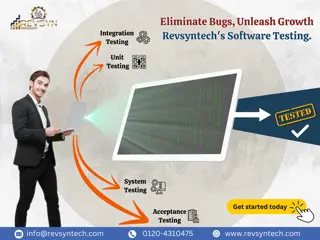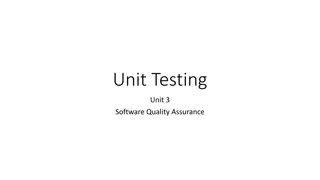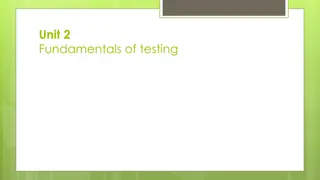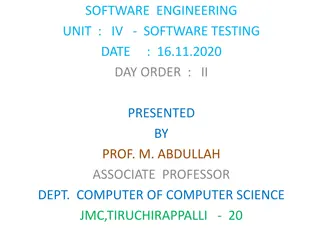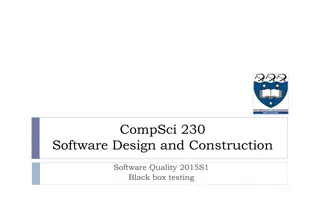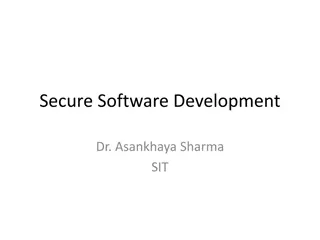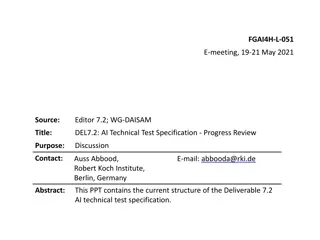Software Testing Principles & Best Practices
This article discusses key principles for effective software testing, covering traceability to customer requirements, early planning, incremental testing, independent verification, operability, observability, controllability, decomposability, and simplicity. Understanding and applying these principles can enhance the quality and efficiency of software testing processes.
Download Presentation

Please find below an Image/Link to download the presentation.
The content on the website is provided AS IS for your information and personal use only. It may not be sold, licensed, or shared on other websites without obtaining consent from the author.If you encounter any issues during the download, it is possible that the publisher has removed the file from their server.
You are allowed to download the files provided on this website for personal or commercial use, subject to the condition that they are used lawfully. All files are the property of their respective owners.
The content on the website is provided AS IS for your information and personal use only. It may not be sold, licensed, or shared on other websites without obtaining consent from the author.
E N D
Presentation Transcript
Testing Principles All tests should be traceable to customer requirements Tests should be planned long before testing begins The Pareto principle applies to S/W testing Testing should begin in the small and progress toward testing in the large Exhausting testing is not possible To be most effective, testing should be conducted by an independent third party
Operability (The better it works, the more efficiently it can be tested) The system has few bugs No bugs block the execution of tests The product evolves in functional stages (allows simultaneoous development and testing)
Observability (What you see is what you test) Distinct output is generated for each input System states amd variables are visible or queriable during execution Past system states and variables are visible or queriable (e.g. transaction logs) All factors affecting the output are visible Incorrect output is easily identified Internal errors are automatically detected through self testing mechanisms Internal errors are automatically reported Source code is accesible
Controllability (The better we can control the S/W, the more testing can be automated and optimized) All possible outputs can be generated through some combination of input All code is executable through some combination of input S/W and H/W states and variables can be controlled directly by the test engineer Input and output formats are consistent and structured Tests can be conveniently specified, automated and reproduced.
Decomposability (By controlling the scope of testing, we can more quickly isolate problems and perform smarter retesting) The S/W system is built from independent modules S/W Modules can be tested independently
Simplicity (The less there is to test, the more quickly we can test it) Fucntional simplicity (e.g., the feature set is the minimum necessary to meet requirements) Structural simplicity (e.g., architecture is modularized to llimit the propagation of faults) Code simplicity (e.g., a coding standard is adopted for ease of inspection and maintenance)
Stability (The fewer the changes, the fewer the disruptions to testing Changes to the S/W are infrequent Changes to the S/W are controlled Changes to the S/W do not invalidate existing tests The S/W recovers well from failures
Understandability (The more information we have, the smarter we will test The design is well understood Dependencies between internal, external and shared components are well understood Changes to the design are communicated Technical documentation is well organized Technical documentation is spesific and detailed Technical documentation is accurate



